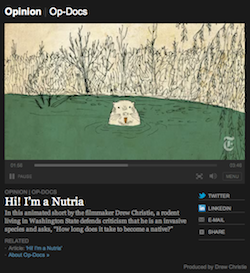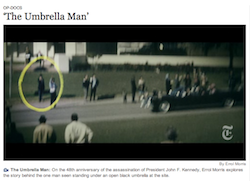
Semiaquatic rodents don’t typically go around penning opinion pieces for The New York Times. Yet a piece told from the perspective of a river rat — also known as a nutria or coypu — recently became one of the newspaper’s most popular video offerings.
“In the video section of the news department, a piece about invasive species would probably have experts talking about invasive species,” said Jason Spingarn-Koff, curator and producer of Op-Docs, a video opinion section that The New York Times launched in November. “You would not have an animated rodent talking about invasive species.”
The video he’s describing is Drew Christie’s four-minute film “Hi! I’m a Nutria,” in which a curious cartoon rodent explores his species’ path to Washington State.
 “I can’t speak out loud so I’m going to talk to you through mental telepathy,” the orange-toothed nutria tells his audience.
“I can’t speak out loud so I’m going to talk to you through mental telepathy,” the orange-toothed nutria tells his audience.
The short film is humorous and information-rich, but it also raises a larger question: How long does it take for someone — an invasive species, a human — to become a native? It’s a subject that filmmaker Christie says has always “fascinated” and “perplexed” him.
“I’ve always wondered why there’s never an official standard like, Once you’ve been here for 75 years and three months you get the official badge,” Christie told me. “Like everything, it’s so vague. Going through a kind of weird, roundabout way of asking the question is sometimes the best way of doing it.”
While the first-rodent perspective makes Christie’s film unusual for the Times, the fact that it raises both timely and enduring questions is what makes Op-Docs special. Here’s how Spingarn-Koff puts it: “How can we combine this unusual storytelling with timeliness, and potentially pioneer a new type of documentary news?”
Op-Docs also has the “heritage” of The New York Times op-ed section at its core. “So rather than a total startup, we are evolving an existing form,” he said. But the newness of the not-yet-five-month-old project also encourages creativity and experimentation.
Here are the rules for what makes an Op-Doc: Films ought not be longer than five minutes, and they have to contain some kind of opinion. But even those guidelines aren’t hard and fast. First of all, opinions — especially when they’re expressed through a visual medium like film — can be subtle. Take, for example, Jeff Scher’s “Focus,” a blurry view of the New York City marathon that Scher shot with a point-and-shoot camera he “tricked into shooting out of focus.”
“Part of what we consider ‘opinion’ is just seeing the world in a new way, and that can sometimes be very simple,” Spingarn-Koff said. “That’s what the marathon piece does. It just says, ‘Look at the marathon runners in an unexpected way.’ Sometimes we want to have pieces that are delightful or entertaining, and I think that’s consistent with the opinion section.”
The length requirements are somewhat malleable, too. “Focus” was only two minutes long, while Ra’anan Alexandrowicz’s film about Palestinian rights clocked in at just under 10 minutes. Filmmakers are also free to experiment in ways that aren’t often found in traditional reporting. That was the case in “Bike Thief,” in which filmmaker Casey Neistat locked up his bike on the streets of New York then ostentatiously “stole” it to see how passersby would react.
“I don’t know if the news department would do something like that,” Spingarn-Koff says. “Someone putting themselves in this incredible situation, and doing an urban psychology experiment, and voicing strong opinions through his experience— it’s just a very different type of storytelling. I think when Op-Docs are most successful — and maybe this is something that’s a little different than news — they’re often about something bigger. They operate on a higher level.”
Here’s the first piece that Op-Docs published, which uses rare footage of Richard Nixon on the campaign trail shot on Super 8 film by his aides, as a way to explore his landslide 1972 victory.
If Op-Docs can find a timelier news peg, all the better. When the president of the Maldives was ousted last month, Spingarn-Koff asked filmmaker John Shenk — who was working on a longer project about the deposed politician — to cut a couple of minutes of film for Op-Docs on short notice. Shenk agreed, and The New York Times coupled his film with an op-ed that the former president had submitted to the newspaper.
“That gave me a sense that Op-Docs can actually have a breaking news function as well,” Spingarn-Koff said. “You don’t really think of documentary filmmaking as having that function. We’re still exploring the power of this outlet and what we can achieve.”
One unexpected achievement: Op-Docs will soon be screened theatrically, in a series at the IFC Center in New York. “You never think of web videos going theatrical,” says Spingarn-Koff, whose favorite way to watch Op-Docs is on an iPad. “You start feeling this is really different than television…We put them out in high definition, and it’s beautiful. We dont have a television station, and we don’t need a television station.”
He won’t provide specifics about web traffic or play counts, but Spingarn-Koff says the response to Op-Docs has been “great.” For filmmakers like Christie, the opportunity to have work showcased on the Times’ website represents a huge opportunity for exposure.
“I could be putting things up on my own for millions of years and it probably wouldn’t get the viewership that it does by being on the homepage of The New York Times,” Christie said. “I have no clue how many views [it got], and I didn’t read any of the comments because I was too scared…The process was all very painless — even the 50 fact-checking emails back and forth.”
(For the record, the comments section in response to Christie’s video is robust with compliments about the film, discussion of what it means to be “invasive,” whether it matters that nutria are cute, and what they might taste like; “possessed of a nutty flavor,” one commenter muses.) [Louisiana-born editor’s note: They kinda taste like rabbit.]
Christie’s “really very cool” experience with Op-Docs included receiving an email from PETA president Ingrid Newkirk, who praised his film and suggested he make one about “how one million chickens are killed per hour,” Christie says. (“I didn’t have the heart to tell her that I had just had chicken for lunch,” he said.)
“Hi! I’m a Nutria” may be Op-Docs’ latest hit, but its first viral success was a piece by Academy Award winner Errol Morris that The New York Times published in November. In “The Umbrella Man,” Morris explores the nature of evidence and investigation by recalling the conspiracy that surrounded the man who stood beneath a black umbrella on the sunny day of Nov. 22, 1963, at Dealey Plaza, and can be seen in the background of photos of John F. Kennedy’s motorcade just before his assassination.
 When John Updike wrote about this “anomalous and ominous” figure for The New Yorker in 1967, he wondered whether “any similar scrutiny of a minute section of time and space would yield similar strangeness — gaps, inconsistencies, warps, and bubbles in the surface of circumstance.”
When John Updike wrote about this “anomalous and ominous” figure for The New Yorker in 1967, he wondered whether “any similar scrutiny of a minute section of time and space would yield similar strangeness — gaps, inconsistencies, warps, and bubbles in the surface of circumstance.”
The search for truth about JFK’s assassination “seems to demonstrate how perilously empiricism verges on magic,” Updike wrote. That idea stuck with Morris, who says for years he’s wanted to make a movie about the assassination investigation that would allow him to indulge his “obsessive interest in the complexities of reality.” That obsession — which requires looking at something up close and from far away at the same time — is part of what makes “The Umbrella Man” such a good fit for Op-Docs.
Here’s how Josiah “Tink” Thompson — an expert on the Zapruder film of the assassination, and the subject of Morris’ short film — puts it: “If you put any event under a microscope, you will find a whole dimension of completely weird, incredible things going on.”
Photo of nutria by cocoate.com used under a Creative Commons license.